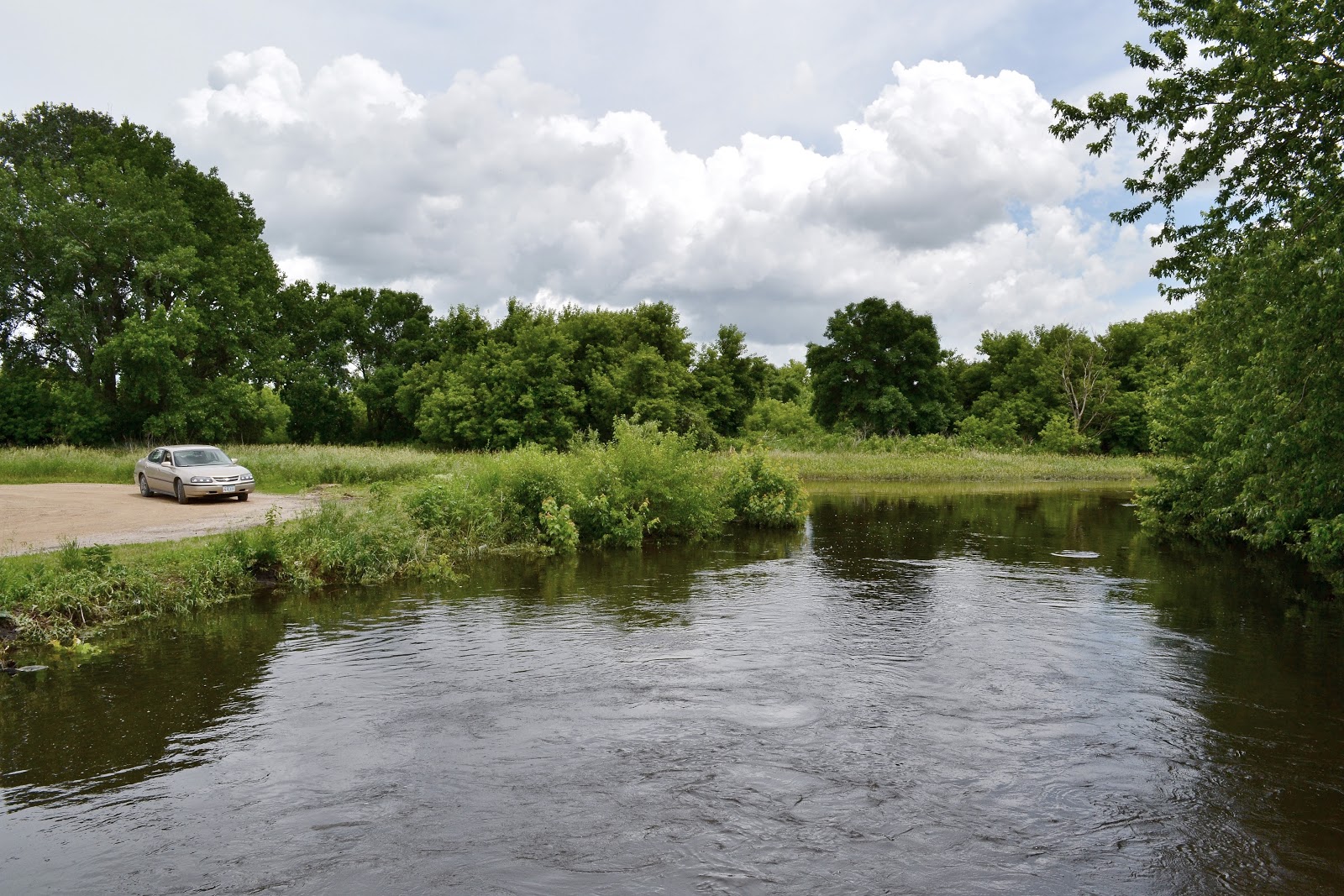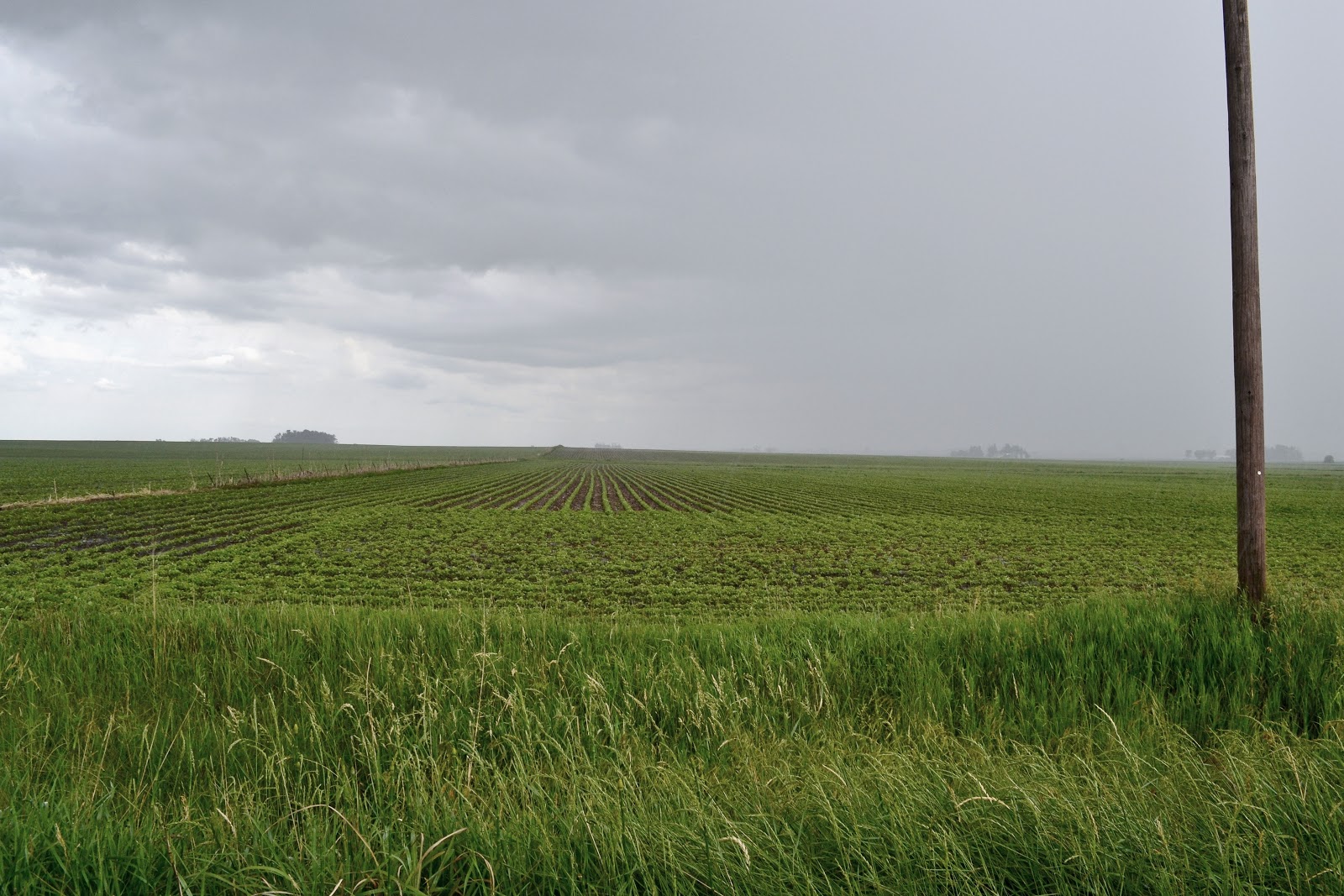I am still working on those special
projects that I mentioned before. I have a lot of time involved in
them, and they will require a lot more work before they are both
completed. In the meantime, I am going to have to resort to smaller
messages and photo journeys in order to keep putting out messages.
I went on a photo journey earlier this
year. I drove for most of a day around Northern Iowa, and then I
decided that I had taken enough pictures of that region; so I headed
for the Mississippi River. My intention was to present a photo
journey from Eagle Grove to the Mississippi River. I completed the
first half of the photographs in one day, and due to circumstances I
had to turn back. My intention was to continue from where I left off,
and then photograph the rest of the journey to the Mississippi River.
That would have (and will) entailed going into the river valley
counties of Iowa, which are quite different from the central plains.
Together, the journey would have been about 200-250 photographs.
I was going to complete the photographs
the next time I had a day off, but then I became injured and I was
not able to do any photography for ten weeks. Now, I am back to work
and I am quite repaired again; so I will be trying to finish this
soon.
*************************
Eagle Grove from the south.
As you may know, I wander when I take
pictures. There are conflicting philosophies about picture taking.
1. You can try to plan out an
itinerary, and attempt to make it happen your way. That works well
with furniture, gravestones, fire hydrants (but, not always), Sears
department stores, church buildings, a bottle of Sun Tea in the
backyard (in the sun of course), and Satan Tubers (which always sit
frozen on furniture, and stare stupidly at TV with their mouths
open). It does not work well with anything alive.
2. Since the subject matter(s) are very
much alive, and could not begin to care about having their
photographs taken -- be very mobile and flexible in your approach,
and seldom plan anything. Maybe, you can decide which area or region
you want to be in.
Eagle Grove the Island.
I almost always use the second method,
which has me zooming about from township to township, or slowly
trolling along at twenty miles an hour looking for pictures. I zoom,
when I am trying to keep up with the clouds and the light. I troll,
when I am in a good place for photographs.
In this trip, I started by going here.
This is the area just above Lake Cornelia. It is the rolling hills
region of Wright County. The last time I showed a photograph from
this intersection, this pond was not here. That is because it is not
a pond. It is actually a cow pasture. However, just before I went out
on this trip it had rained heavily. Indeed, one of the reasons why I
went out that day was to take pictures of any flooding that was
happening.
I stopped along the road to look north
for signs of flooding. Then, I saw this curious bird and took a shot
of it. Little did I know how much birds were going to be a part of
this photo journey.
The road runs west to east, and this is
looking back to the west. What I stopped for was the view from the
trees that you see on the right (north) side of the picture.
I watched that bird for a moment, and
then it chirped and three little babies appeared out of the grass;
and they all ran off into the trees on the top of the hills -- like a
family out of a Brother's Grimm Fairy Tale. [[Highly recommended
reading by the way. Their 'fairy tales' are actually stories, legends
and fables. And, there are no faggots in them at all!]]
Then, I decided to make a panorama out
of that sight.
This is what I had actually stopped to
see. It is one of my favorite views of Wright County, and it is
typical of the county.
Further to the east, we come to the
view of Belmond from the rolling hills. The pond there, is the one I
have shown pictures of before. It is rich with wildlife, from frogs
to deer; both of which are usually too quick for my camera.
The next eight photographs show the
pond itself. If you know anything about ecology, you will recognize
the richness of the environment there.
Looking north.
Looking north.
Looking east.
Looking west. There was a mommy duck
and three small ducklings hiding in the reeds there. They saw me just
as I saw them, and they scampered into the vegetation.
Looking northwest.
Looking down.
Local resident.
Looking up, I was surprised to see my
arch enemies of Nature Photography flying in formation over my head.
Yes, none other than the illustrious, elite, forever-primped, and
aloof -- Great White American Pelicans. I had expected a few ducks. I
had expected trying to get some long range shots of disappearing
ducks. There were no ducks, not even Grand Dad Heron was there today.
These are the absolute most difficult
birds in all of America to get pictures of. Period. You can always
bait Hummingbirds. Nothing attracts the Great White American
Pelicans, except other Great White American Pelicans.
Five of them soared about up there,
high over my insignificant and lowly and unwinged head, for about
fifteen minutes.
They showed no intention of landing,
and I began to suspect that I was being lined up for target practice.
They came a bit lower, and I took this
photograph. Notice the lower wing sections have broad black areas.
The rest of the bird is pure white except for its long yellow beak.
And, such a handsome beak. Maybe if I flatter them, they will let me
take some closeups.
If they did, it would be the first time
in the History of the Known Universe.
From the north appeared two more
pelicans, and these were determined to land on the pond.
Well, I drove a bit to the east and
circled around so I was north of the pond. This area has many small
ponds and glacial pits. Plus, it had rained a lot recently. Not far
away, I surprised the second most difficult bird in America to
photograph. I stopped with a screech and snapped this shot. This is
probably a grandson of Grand Dad Heron of the Pond.
Now, I began to roam about. I went over
to Belmond and got some munchies at the supermarket, to sustain my
further adventures. Then, I headed west out of town on a track that
would take me further north and possibly into Hancock county.
At one of the farms along the road I
saw these two standing under a tree. This is one of their favorite
places, look at the ground underneath them. From there, they can
watch all of the county go by in steel idiots.
Just a little ways to the west, I
stopped again and took some panorama shots. As all of this is
literally a photographic record of Iowa before it is killed by
ButtUgly Windmills from New Jersey -- pictures such as this are
priceless. At the far left of the panorama, you will see a black bird
sitting on the telephone wires, minding its own business. Do not be
fooled. That bird is watching every move I make. That, is the most
intelligent and talented black bird in Iowa. Waiting for a chance to
audition.
I stopped the Cashmere just beyond him,
which I am sure disappointed him. But then, I bounced out of the car
with my camera and began to talk to him and take photographs.
His chance at last! He had been waiting
since January to show someone how well he could dance in the air! He
swooped and dove and climbed and pirouetted and dove again and
hovered while flapping his wings!
Then, he would land on the telephone
wire again and wait for the applause. Bravo! Hurrah! “What a Great
Bird!” I shouted and danced about in the middle of the road.
Seeing me dance, he shot up into the
air again and swerved and spun and chirped often and dove and climbed
and whirled about. Then, he would land and wait for me. I would shout
approvals again and dance in the middle of the road. [[No one else on
the road for ten miles in any direction, anyway.]]
The more I made sounds and danced, the
more he flew about in a great display of his avian talents and
chirped. Finally, I had about twenty pictures of him and I called it
quits. He landed on the wire again and asked what was wrong. I just
left.
I boosted all of the controls in this
copy to see what he really looks like. He is literally solid black,
including legs, feet, and beak.
This day was very mixed for weather. An
area that was rained on one hour would get full Star Lux the next
hour, as storms moved through rapidly. It was just the kind of day
(and light) that makes for good photography. To the east, the skies
were clear for awhile; so I headed towards Iowa Falls. Of course,
when you say 'Iowa Falls' you naturally think of the Iowa River. This
picture shows the Iowa River Greenbelt southeast of Dows. The water
you see is flood water filling a field. The river itself is out of
sight on the other side of the trees.
Now, I am strolling along the road that
follows the greenbelt towards Popejoy. The Iowa River is far over its
banks. These trees are usually on dry land.
As you can see, the greenbelts are
where most of the forest in Iowa are.
You can see it better here. The Iowa is
usually a small river at this point, but here it is about as wide as
the Cedar is normally; because of the flooding.
This is flood stage for sure. The river
is usually just a path of water between these trees, with grass
covered banks.
Further east, towards Iowa Falls, I
came across this small creek that is now up to flood stage. As I have
mentioned before, this species of bird lives under the small bridges
that cross the canals and streams.
Usually, that stream is only one sixth
this size.
The birds are flying about because the
Impala is parked on the bridge, which shakes the bridge and wakes
them up. These birds are most active at dusk, when the bug activity
is at its height.
This is the town of Alden, on the way
to Iowa Falls. As you can see there is a considerable amount of water
coming over the falls here. The next six photographs are of Alden.
This is Iowa Falls. The river runs
right through the city, giving it an attractive atmosphere. I would
rather travel twice as far to shop here instead of Fort Drudge.
East of Iowa Falls. This mouser looks
well fed. He's a farm cat though. Otherwise, he would not look nearly
so clean.
Well, one would expect that I would
continue eastwards, but the weather often dictates my movements out
here. This shot is far to the west again, back in Wright County.
At one of the branches of the Iowa
River, this time in Hancock County to the north.
This could be a desktop background
picture for someone. I use it that way myself.
I made a kind of a loop east and then
north and then west again, and hit the same river further upstream.
Here, I took this picture looking south and the next picture looking
north.
So here I am, at one of my favorite
lakes, thinking that this photo run is just about done; and I am
going to go home and paint something in my garage -- when I walk out
onto a pier and look down.
I took these pictures because of the
interplay of light and water bugs and water patterns.
For a while, I continue west. However,
as I travel I curve around again and start going east again. I cross
I35 for the third time today and decide to make one big photo
collection from Eagle Grove to Guttenberg on the Mississippi.
In the storm there are many downpours
(cells). These are not all the same cell that you are seeing. At this
small town of Aredale, with a few houses and this grain elevator, it
was raining very much; because there was a cell overhead.
By now, I have decided to go home and
continue this at Greene on my next day off -- which never happened.
So, now I am driving southwest back to Eagle Grove and I am taking
pictures of rain cells that I pass along the way.
Inside one more rain cell, and then I
am clear of them and going home.
Over on Rt 69 near Clarion, I stopped
and took a view of the storm system as seen from afar. From here, it
looks like one single unit; but as we saw, it is actually subdivided
into many cells within.
*************************
Markel Peters




































































































